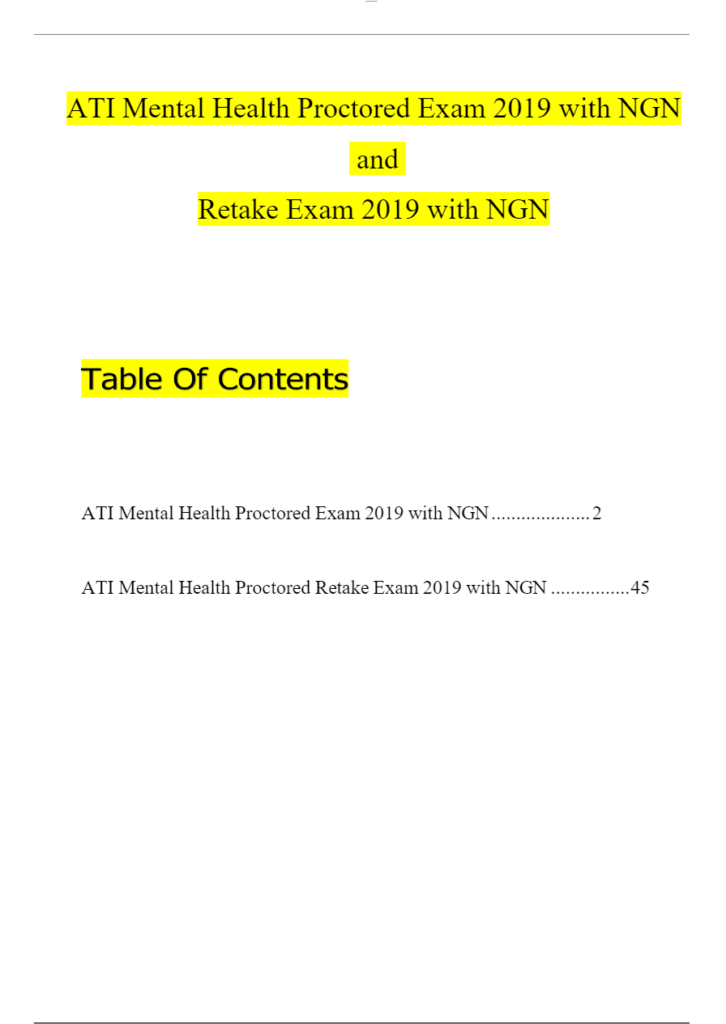2023 ATI Mental Health Proctored 2019 NGN Exam and Retake Exam Questions and Answers (Verified Answers) 2023 ATI Mental Health Proctored 2019 NGN Exam and Retake Exam Questions and Answers (Verified Answers) 2023 ATI Mental Health Proctored 2019 NGN Exam and Retake Exam Questions and Answers (Verified Answers)

lOMoAR cPSD| 9700590
ATI Mental Health Proctored Exam 2019 with NGN
and
Retake Exam 2019 with NGN
ATI Mental Health Proctored Exam 2019 with NGN………………..2
ATI Mental Health Proctored Retake Exam 2019 with NGN …………….45
lOMoAR cPSD| 9700590
ATI Mental Health Proctored Exam 2019 with NGN
1.A client is fearful of driving and enters a behavioral therapy program to
help him overcome his anxiety. Using systematic desensitization, he is able
to drive down a familiar street without experiencing a panic attack. The
nurse should recognize that to continue positive results, the client should
participate in which of the following?
a. Biofeedback
b. Therapist modeling
c. Frequent pacing
d. Positive reinforcement
- A nurse is counseling a client following the death of the client’s partner 8
months ago. Which of the following client statements indicates
maladaptive grieving?
a. “I am so sorry for the times I was angry with my partner.”
b. “I like looking at his personal items in the closet.”
c. “I find myself thinking about my partner often.”
d. “I still don’t feel up to returning to work.”
Rationale: 8 months too long Maladaptive Grief: . Distorted or exaggerated grief response – unable to
perform activities of daily living.
RISK FACTORS FOR MALADAPTIVE GRIEVING
lOMoAR cPSD| 9700590
●● Being dependent upon the deceased
●● Unexpected death at a young age, through violence, or by a socially unacceptable manner
●● Inadequate coping skills or lack of social support
●● Pre-existing mental health issues, such as depression or substance use disorder
3./21 A nurse in an inpatient mental health facility is assessing a client who
has schizophrenia and is taking haloperidol (anti-psychotic, 1st gen).
Which of the following clinical findings is the nurse’s priority?
a. Headache
b. Insomnia (sedation)
c. Urinary hesitancy (Complication → ANTIcholinergic effects)
d. High fever (Complication → agranulocytosis)
Other complications: Acute dystonia, Pseudoparkinsonism, Akathisia, Tardive dyskinesia,
Neuroendocrine effects (Gynecomastia, Weight gain, Menstrual irregularities), NMS, Orthostatic
Hypotension, Sedation, Sexual dysfunction, Skin effects, Liver impairment
lOMoAR cPSD| 9700590
- A nurse is planning care for a client who has obsessive compulsive
disorder. Which of the following recommendations should the nurse include
in the client’s plan of care?
a. Reality Orientation therapy (re-orient to reality)
b. Operant Conditioning (receives positive rewards for positive behavior)
c. Thought Stopping (say “stop” when compulsive behaviors arise & substitute w/
positive thought)
d. Validation Therapy (acknowledging pt’s feelings) - A nurse is providing teaching to the daughter of an older client who has
obsessive-compulsive disorder. Which of the following statements by the
daughter indicates an understanding of the teaching?
a. “I will provide my mother with detailed instructions about how to perform
self-care.” (Give simple directions)
b. “I will limit my mother’s clothing choices when she is getting
dressed.” (If client is indecisive, limit the client’s choices; if client still unable to make a decision,
give client one outfit to wear)
c. “I will wake my mother up a couple of times in the night to check on her.”
d. “I will discourage my mother from talking about her physical complaints.” - A nurse is caring for a client who is in the manic phase of bipolar
disorder. Which of the following actions should the nurse take?
a. Provide in depth explanation of nursing expectations (inability to focus –
give concise explanations)
b. Encourage the client to participate in group activities (decrease
stimulation)
c. Avoid power struggles by remaining neutral (do not react personally
to pt’s comments)
d. Allow the client to set limits for his behavior (nurse sets limits)
download pdf at https://learnexams.com/search/study?query=aqa
